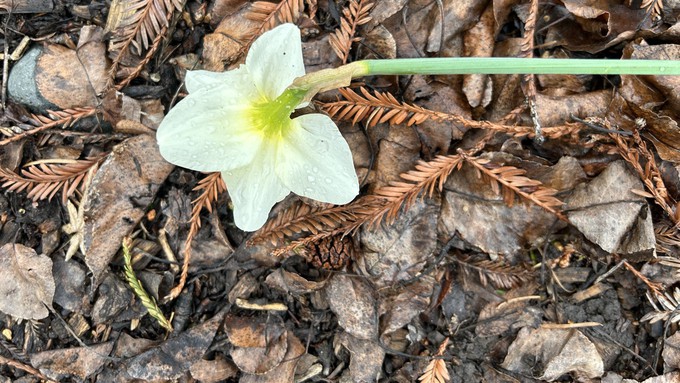
High temperatures take a 20-degree dip from last weekend's warmth

This poor daffodil, wet and face down in muddy mulch, may well epitomize the weather situation for Sacramento gardeners. Kathy Morrison
March came roaring in like a wet, cold lion. Will it leave like a lamb?
As we turn the calendar, Northern California is in the midst of another good soaking – this one much colder than the almost-tropical atmospheric rivers that hit last week. This current storm – dubbed a “blizzard maker” by meteorologists – will drop snow as low at 1,500-foot elevation in the Sierra foothills. Meanwhile, it will be very damp and chilly down here in the greater Sacramento area.
The temperature difference is enough to cause daffodil whiplash. Last weekend, our gardens basked in record-high 70-degree sun. This weekend, we’ll be lucky to see the low 50s. Saturday’s expected high in Sacramento is only 51 degrees with a low of 43.
In other words, our early spring is on hold.
As for rain, February proved to be very soggy. According to the National Weather Service, downtown Sacramento totaled 4.63 inches of rain; that’s 41% more than average for the month.
March tends to be on the wet side, too. And March 2023 was practically a deluge. That month totaled more than 5 inches of rain in Sacramento. Our normal rain total for the month: 2.68 inches.
This March, these first few days will get us off to a very wet start; rain is in Sacramento’s forecast every day through Wednesday.
Temperatures definitely will feel on the cool side, with days about 10 degrees below normal. March averages highs of 65 degrees and lows of 44. (Fortunately, overnight lows will just be in the 40s instead of dipping into the 30s.)
But those cold, damp days will keep our soil cold and damp, too. Until soil warms significantly, forget about transplanting outdoors any warm-season veggies.
While this cold, wet weather may have put a damper on outdoor gardening, make the most of indoor time. In the cozy (dry) comfort of your kitchen, start some seeds of summer favorites.
Aim to move those baby tomatoes, peppers and squash outdoors when the soil temperature finally warms significantly. Judging by current weather models, that will be sometime in late April or early May.
For the latest on Sacramento weather: https://www.weather.gov/sto/#
Comments
0 comments have been posted.Sacramento Digs Gardening to your inbox.
Sites We Like
Garden Checklist for week of April 21
This week there’s plenty to keep gardeners busy. With no rain in the immediate forecast, remember to irrigate any new transplants.
* Weed, weed, weed! Get them before they flower and go to seed.
* April is the last chance to plant citrus trees such as dwarf orange, lemon and kumquat. These trees also look good in landscaping and provide fresh fruit in winter.
* Smell orange blossoms? Feed citrus trees with a low dose of balanced fertilizer (such as 10-10-10) during bloom to help set fruit. Keep an eye out for ants.
* Apply slow-release fertilizer to the lawn.
* Thoroughly clean debris from the bottom of outdoor ponds or fountains.
* Spring brings a flush of rapid growth, and that means your garden is really hungry. Feed shrubs and trees with a slow-release fertilizer. Or mulch with a 1-inch layer of compost.
* Azaleas and camellias looking a little yellow? If leaves are turning yellow between the veins, give them a boost with chelated iron.
* Trim dead flowers but not leaves from spring-flowering bulbs such as daffodils and tulips. Those leaves gather energy to create next year's flowers. Also, give the bulbs a fertilizer boost after bloom.
* Pinch chrysanthemums back to 12 inches for fall flowers. Cut old stems to the ground.
* Mulch around plants to conserve moisture and control weeds.
* From seed, plant beans, beets, cantaloupes, carrots, corn, cucumbers, melons, radishes and squash.
* Plant onion sets.
* In the flower garden, plant seeds for asters, cosmos, celosia, marigolds, salvia, sunflowers and zinnias.
* Transplant petunias, zinnias, geraniums and other summer bloomers.
* Plant perennials and dahlia tubers for summer bloom.
* Mid to late April is about the last chance to plant summer bulbs, such as gladiolus and tuberous begonias.
* Transplant lettuce seedlings. Choose varieties that mature quickly such as loose leaf.